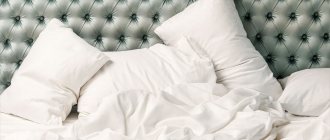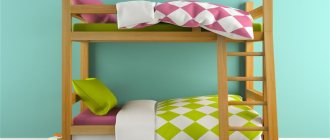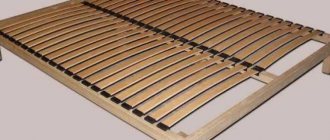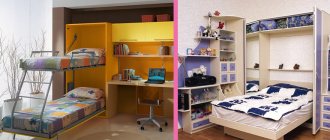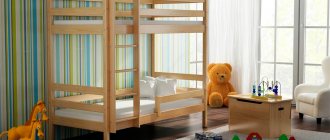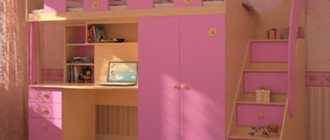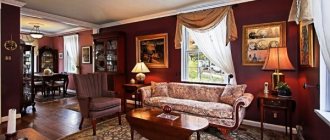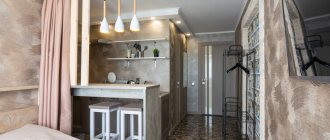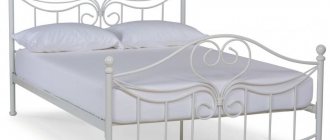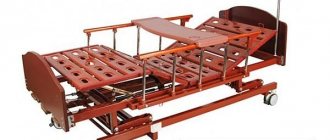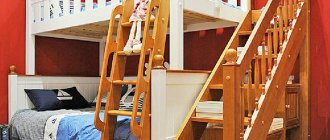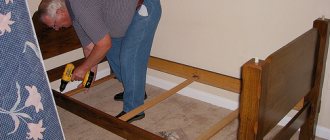Modern home textiles, in particular, rugs and bedspreads, are not only used for their intended purpose, but also serve as an element of decor for the sleeping area and the bedroom as a whole. Often these home textiles are made from expensive natural materials and look like an important decorative element.
A blanket made of light, voluminous knitwear or a bedspread made of expensive fabric requires a special place after it is removed from the bed. In addition, bedspreads can be quite bulky and take up a lot of space. We’ll tell you in our article how and where to put them near the bed so as not to clutter up the space and disturb the harmony of the room’s interior.
On the banquette
A banquette is often placed at the foot of the bed - a small bench, usually with a soft seat. Sometimes the banquette has armrests. Such furniture not only decorates the interior, but also serves as additional storage space. Blankets and bedspreads can be conveniently placed on a banquette. In addition, you can put an extra blanket on it during the cold season and spare pillows.
LiveInternetLiveInternet
Many women wonder how to make their bedroom cozy. Let's think about what, when entering the bedroom, we pay attention to first of all? Of course, the largest piece of furniture is the bed. And if your bed is a pile of pillows, crumpled blankets and sheets, what kind of comfort can we talk about? But if the bed is neatly tidied and covered with an elegant bedspread that harmoniously matches the rest of the room’s interior, then such a bedroom will probably not be a shame to show off to guests.
But what to do if the bed has a non-standard size or there is no way to choose a bedspread that matches the color scheme? If you are the happy owner of a sewing machine, then there is a solution - you can sew a bedspread for the bedroom yourself. "How?" - you ask - “Is it so easy?” With the help of our material, you can easily cope with this task, because now we will tell you how you can sew a bedspread yourself.
As we have already said, the bedspread on the bed concentrates a significant part of the attention on itself. The more elegant and magnificent it is, the more beautiful and sophisticated the bedroom as a whole will look. It is best if the bedspread covers the bed completely, in which case the bedroom design will take on a finished look.
So, how to properly sew a bedspread?
The bedspread will look perfect if you additionally trim it with edging. The edging can be cut out from the remnants of fabric or you can choose a suitable one-color fabric or fabric with a pattern that will harmonize with one of the shades of the fabric - this will be an additional finish.
What fabric is best to make a bedspread from?
We suggest choosing fabrics with a tight weave for the bedspread: such fabrics are easy to work with, besides, they fit snugly and will reliably hide the entire bed. To properly sew a bedspread for the bedroom, you need to take into account a number of small tailoring tricks:
- when cutting, you need to take into account the direction of the pattern and the flow of the fabric;
- if the bed has a backrest at the foot and head, you will need to sew a continuous frill, or from sections that will fit the legs;
- Any length is acceptable - you can leave the bedspread longer than the bed, on the floor, covering the legs, or leave them open if you think they are beautiful.
Before sewing a bedspread, you need to carefully and correctly calculate and cut the fabric.
Cutting fabric
- We cut out the main canvas. We measure the length and width of the mattress, add 3 cm for seam allowances.
- We cut out the frills. I will give an example for clarity. If you want a fluffy frill, you need to multiply the length and width of the main part by 2. Let’s say the length of the bedspread is 2 meters and the width is 1.60 m, the width of the frills will be 2x2 = 4 m in length and 2x 1.60 = 3.2 m along the width of the main part. The height of the frill is equal to the desired height plus 3.5 cm for seam allowances and hems. We monitor the alignment of the pattern at the joints of the seams.
Assembling the cut parts
- We connect the side parts. We sew the frill details into a ring so that the seams coincide with the corners of the main fabric.
- We sew the edging. To do this, we cut out two edges of the same length as the side parts, add 2.5 cm to the seams and hem. Fold the right sides inward and baste the open edge of the edges to the main panel. We cut the edge allowance in the corners so that it lies evenly.
- We bend the frills. Fold the hem twice, one centimeter from the bottom and top edges of each frill strip, cutting the corners at an angle of 45°, and iron. Attach the hem.
- Divide the frills into equal sections. We divide the length of the main panel into three equal parts, and the width into two, mark the points along the edge of the edging with pins. We measure the frill and mark the same parts of the sections.
- Let's assemble. To do this, you need to sew two lines for gathers in parallel at a distance of 0.5 and 1.5 cm from the raw edges of the frill, start and finish sewing at the marks.
- We sew the frills. We fold the parts face inward, combine the open sections, and pin the frill near the marks of the main fabric. We tighten the threads of the gathering stitches, adjusting them in length, chop and baste the frill and the fabric together.
- We use a special zipper foot and sew the frill close to the edging. Now you can open the gathering seams.
How to sew a patchwork blanket?
Before sewing a patchwork bedspread, we select suitable scraps of square or triangular shape and connect them together until they become equal in area to the area of the main fabric of the product. We process it with piping or bias tape.
How to sew a quilted bedspread?
To sew a quilted bedspread, we select lighter fabrics and make marks on the fabric of the desired width between the lines, for example 5x5 cm. We baste or pin the fabric and padding polyester with pins at the intersections of the lines and lay the lines along the marked lines. If you have a special patchwork foot, install it on your sewing machine before sewing the blanket.
Cut and sew series of posts:
Part 1 - No Title Part 2 - No Title Part 3 - No Title Part 4 - No Title Part 5 - How to Sew a Bedspread Part 6 - No Title Part 7 - No Title... Part 26 - My Cherry bunny... Part 27 - More than 100 MK videos from Olga Nikishecheva Part 28 - Original ideas for sewing kitchen aprons
In the compartment inside the bed
Most popular models of modern beds have special storage areas for bulky bedding. This can be one large compartment for a model with a lifting mechanism, or several drawers under the berth. There are models that have a niche behind the back of the headboard. It can be shallow or quite spacious. Niches behind the headboard are suitable for storing bedding in small bedrooms with a minimum of furniture.
Contrasting scheme
The headboard contrasts clearly with the wall or the bedroom as a whole.
This option is suitable for those who prefer some sharpness and maximum clarity of lines in the interior. Contrast allows you to make a convincing emphasis on the shape and size of the headboard.
This circuit has several subcircuits.
1. The color of the back is exactly the opposite of the color of the wall. For example, a black bed against a white wall or a beige one against a brown one.
2. The headboard and wall have the same color, but different saturation. For example, near a light gray wall there is a dark gray bed, near a blue wall there is a blue one, etc.
3. A bed with a bright colored headboard in a neutral interior.
4. A bed with a bright colored headboard as an accent in a colorful interior.
5. A bed with a neutral headboard near a colored wall (dark next to a light one or light against a dark background).
In a plastic storage box
If the design of the bed does not provide storage compartments, but it has high legs, then in this case the option with mobile plastic drawers is suitable. You need to choose one or two plastic drawers of a suitable size that will fit freely under the bed. Plastic is easy to use, does not absorb dust, and is easy to clean. A good option would be a box made of transparent plastic with a lid and wheels.
What do the bedspreads look like?
Bedspreads, even those that are inexpensive, are usually double-sided, made of two layers of fabric. Good models may have a layer of insulation between them, for example, padding polyester (“Marianna”). Such bedspreads are quilted - i.e. stitched with threads or glued (this is called thermal stitching and is used in cheap models). The stitch holds the insulation tighter and at the same time adds charm and “homeliness” to the bedspread. Also, some manufacturers decorate bedspreads with veils, embroidery, fringes, and frills.
On a special hanger
Manufacturers of furniture and furniture accessories offer a variety of hangers for large items, namely: blankets, bedspreads and blankets. Hangers can be either floor-mounted or hanging, mounted on a wall or even on a door. Floor hangers often have two or three crossbars, which allows you to conveniently and compactly place several bulky items on it at once. This hanger is mobile and does not take up much space, which is important for small rooms and small bedrooms.
Bed and wall color
When deciding what color of bed to choose, you can follow several rules.
- Contrast with the walls . This is the most effective and expressive option - due to the sharp contrast of the furniture relative to the surrounding space, the room will look dynamic. Classic combinations: white and black, beige and deep brown, brown and light gray. Contrast can be not only between light and dark, but also between bright and neutral. For example, a bright blue wall and a white bed.
- To match the walls . If you choose a bed whose headboard matches the color of the wall behind it, then all together this will create the effect of a single plane. This technique is used to visually increase the space of a room, so if your bedroom cannot boast of spaciousness, take note. To prevent such an interior from being completely monochromatic and faceless, add a few accents through accessories, textiles, bedside tables or poufs.
- Bed in the color of the pattern on the walls . A clear contrast between the shade of the bed and the active pattern on the walls will most likely look tacky and too heavy. If the walls in the room are decorated using an ornament consisting, for example, of green and white parts, choose a bed with a white or green headboard.
In designer furniture
- Decorative chest. This type of designer furniture regularly appears in the interiors of modern designers. The chest fits well into the interior of most bedroom styles. It can be placed at the foot of the bed, and also, if possible, placed next to the bed or against a free wall. It is perfect for storing bedspreads and blankets removed from the bed before bed.
- Bench + cabinet for linen. There is a design option that combines a bench for a seat and storage drawers underneath it. Most often it is located at the foot of the bed and forms a single ensemble with it.
How to choose the right bed?
When decorating a bedroom interior, difficulties often arise when choosing a bed.
Before purchasing, you need to pay attention to the following aspects:
- Height from the floor. In standard models it is 50-63 cm. For older people and tall people it is better to choose a higher bed
- Reliable frame.
- Comfort of the mattress.
- Bed base. Options with metal meshes and gratings are considered obsolete.
Before purchasing, it is better to make a list with the desired criteria. Those who like to change furniture frequently should not purchase a very expensive exclusive bed. Most likely, in a couple of years you will want to change the interior.
Selection of sizes according to individual parameters
Furniture manufacturers recommend adding 30 cm to a person’s height, this will be the size of the ideal bed for him. Some people need more space. Others prefer simple furniture. The standard bed size is about 190-200 cm. Tall people should order a mattress.
The width of the sleeping bed also matters. The minimum standard is 140 cm; this is the type of bed that can comfortably fit two adults.
You can calculate the size of the bed using the parameters of the frame, taking into account the structural features of the base
King-size beds are in demand. This type of furniture is distinguished by its stable frame and therefore can withstand heavy loads. The width of this bed is up to 220 cm, so this model is well suited for tall people and those who value free space.
Ergonomics
Compliance with the principles of ergonomics will allow you to fully relax. Designers advise choosing a large bed. However, it should not create a feeling of cramping. The distance between bedside tables and other objects should be at least 70 cm. This rule also applies to the dressing table in the bedroom.
To correctly place the bed in the bedroom, consider the location of the room in relation to the sun
A mattress that is too soft has a bad effect on your posture. The pressure should be distributed evenly. A mattress that is too hard will also be uncomfortable to sleep on. The best upholstery options are cotton and sheep's wool. For small rooms, furniture with protruding parts is undesirable. It will prevent movement around the bedroom.
